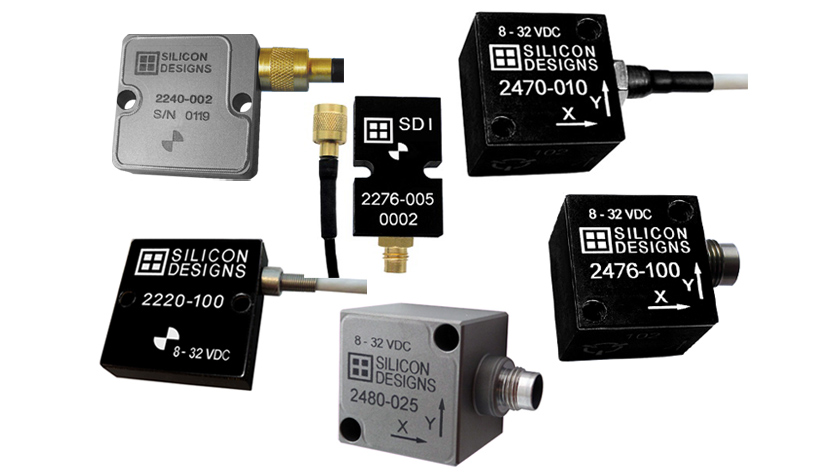
What you need to consider when selecting a DC MEMS accelerometer
When selecting a DC MEMS accelerometer for test and measurement applications, several critical specifications must be considered to ensure the sensor meets the requirements of the specific application. Here are the most important specifications:
Measurement range
- Definition: The maximum and minimum G acceleration levels the accelerometer can accurately measure.
- Importance: The measurement range must match the expected acceleration levels in your application. If the range is too low, the sensor may saturate and miss critical data. If it’s too high, the sensor may lose sensitivity and accuracy in lower acceleration ranges.
Sensitivity
- Definition: The output voltage per unit of acceleration, typically expressed in mV/g.
- Importance: Higher sensitivity allows for more precise measurements of small accelerations. However, higher sensitivity usually corresponds to a lower measurement range.
Bandwidth
- Definition: The frequency range over which the accelerometer can accurately measure acceleration, typically expressed in Hz.
- Importance: The bandwidth must cover the frequency range of interest in your application. For instance, high-bandwidth sensors are needed for capturing fast vibrations or shocks, while low-bandwidth sensors are better suited for slow movements or static measurements like tilt.
Output noise density
- Definition: The level of noise in the accelerometer’s output, typically expressed in µg/√Hz.
- Importance: Lower noise density allows for more accurate detection of small signals, especially in applications requiring precise measurements of low-amplitude vibrations or tilts.
Output impedance
- Definition: The resistance to the flow of current in the accelerometer’s output, typically measured in ohms (Ω).
- Importance: Impedance is important, especially for maintaining signal integrity over long cable runs and ensuring proper matching with the input impedance of the readout circuitry. Low output impedance is generally preferred to minimize signal loss and reduce noise susceptibility.
Temperature range
- Definition: The range of temperatures over which the accelerometer can operate reliably, typically expressed as a minimum and maximum operating temperature.
- Importance: The operating temperature range is crucial for applications where the accelerometer will be exposed to extreme temperatures, whether hot or cold. Performance characteristics such as bias stability, sensitivity, and noise can be affected by temperature, so ensuring the accelerometer can function accurately within the expected environmental conditions is essential.
Temperature coefficient
- Definition: The change in accelerometer performance with temperature, typically affecting sensitivity, offset, and bias stability.
- Importance: In environments with varying temperatures, a low temperature coefficient is crucial to maintaining consistent performance.
Bias stability
- Definition: The long-term drift in the accelerometer’s zero-g output, typically measured in µg over a specified time period.
- Importance: Low bias stability is essential for applications requiring high precision over time, such as seismic monitoring or long-term structural health monitoring.
Linearity
- Definition: The degree to which the accelerometer’s output is proportional to the input acceleration across its measurement range.
- Importance: High linearity ensures that the accelerometer provides accurate measurements across its entire range, which is critical for applications that experience a wide range of accelerations.
Cross-axis sensitivity
- Definition: The sensitivity of the accelerometer to accelerations along axes other than the primary axis of measurement.
- Importance: Low cross-axis sensitivity is important for ensuring that the accelerometer only responds to acceleration in the intended direction, which is critical in precision measurement applications.
Power consumption
- Definition: The amount of power the accelerometer consumes during operation.
- Importance: For battery-powered or portable applications, low power consumption is crucial to prolonging battery life and maintaining system efficiency.
Size and weight
- Definition: The physical dimensions and mass of the accelerometer.
- Importance: Compact and lightweight accelerometers are ideal for applications where space is limited or where the added weight could affect the system being measured, such as in aerospace or wearable technology.
Shock survivability
- Definition: The maximum shock level the accelerometer can withstand without being damaged, usually expressed in g.
- Importance: High shock survivability is necessary in environments where the sensor may experience sudden impacts, such as in automotive crash testing or industrial machinery monitoring.
By thoroughly assessing these specifications, you can select a DC MEMS accelerometer that delivers the required accuracy, reliability, and performance in your specific application environment.
At Kvalitest, we proudly represent Silicon Designs DC MEMS accelerometers, which stand out and excels in every critical specification, delivering superior quality and performance over any competition.
Download the datasheets for Silicon Designs DC MEMS accelerometers below and see the difference for yourself.